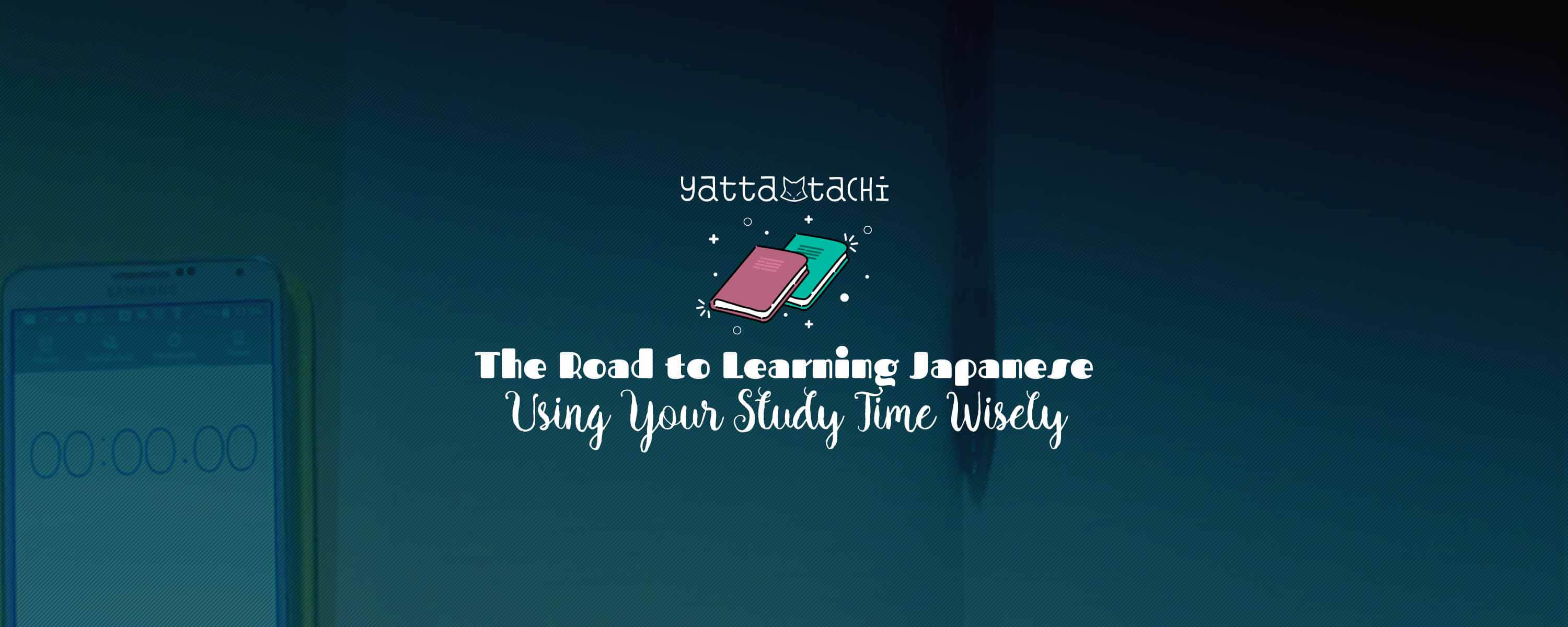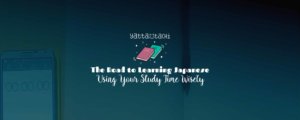“Am I using my time wisely when I study Japanese?” I asked myself this one day as I was beginning to prepare for July’s JLPT (Japanese Language Proficiency Test). It always seemed as if I was studying kanji; specifically, as if I was always using WaniKani. Don’t get me wrong: I consider WaniKani to be an indispensable tool when it comes to studying kanji. However, my kanji skills seemed like the only part of my Japanese abilities that consistently improved. I decided to measure how I spent my time studying and use that information to improve the way I approach learning Japanese.
Measuring My Study Time
The first thing I needed to figure out was how to keep track of each activity’s time. I decided to download a productivity app called aTime Logger – Time Tracker. Within the app, I made different icons for each resource I used. Of course, you could always use a stopwatch and enter the results in a spreadsheet. I split my resources up as follows: WaniKani reviews, WaniKani lessons, Anki reviews, Anki lessons, Tobira learning (grammar), Tobira learning (vocabulary), Tobira review, N3 Speedmaster, reading/listening practice, and the JET Japanese course. (The JET Program offers its own online course for ALTs.) I wanted to see how much time I spent reviewing versus learning new material, so I split things some things up. I only timed myself when I studied during the work week for a total of 26 days.
The Results
Study Time – Total
The first chart we’ll look at compares my time spent reviewing old material versus learning new material. Defining “learning” and “reviewing” was a little complicated. For example, there were times when I came across grammar points in my N3 Speedmaster book that I already knew. However, most of my time was spent learning new grammar points. Reading and listening practice always has a mix of old and new material. My emphasis is almost always on what I don’t understand (things that are new to me), though. Thus, items that I placed under “review” are: WaniKani reviews, Anki reviews, and Tobira reviews. Items I placed under “learning” are: WaniKani lessons, Anki New Cards, Tobira learning (grammar and vocabulary), N3 Speedmaster, and Reading/Listening Practice.
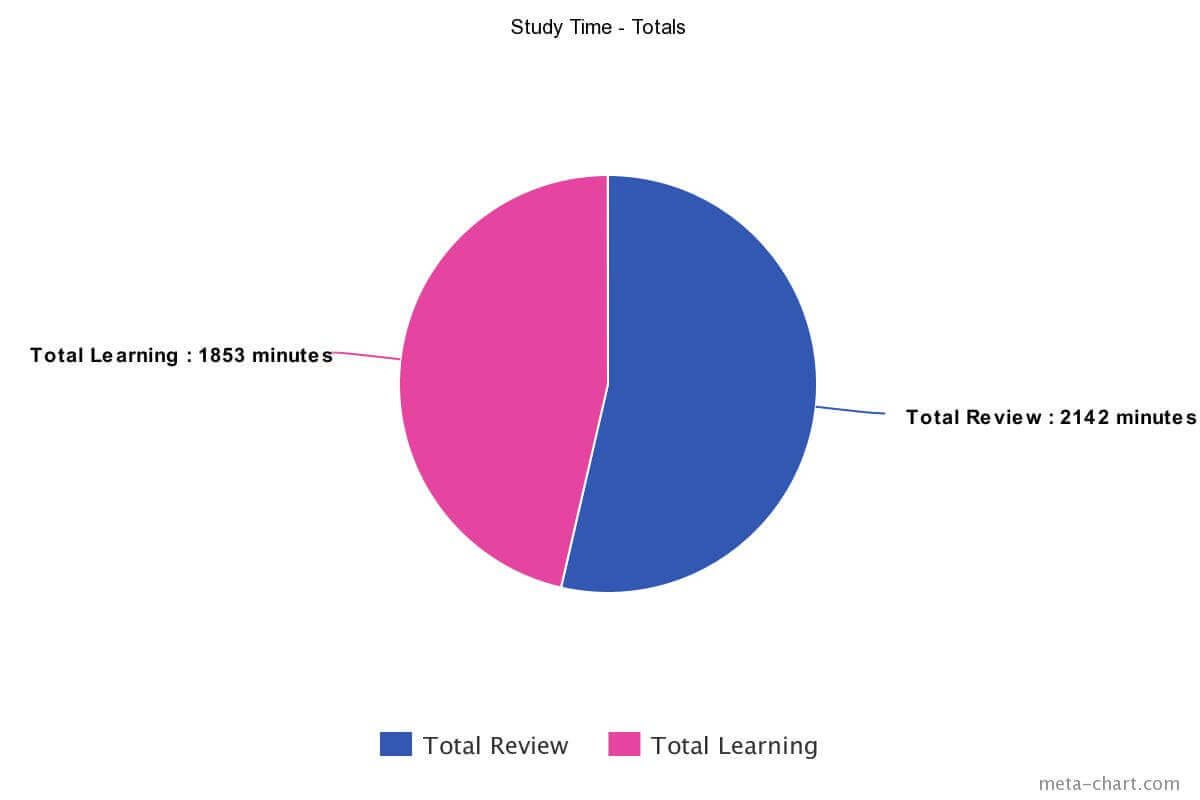
Thoughts on the Data for Study Time – Total
While these aren’t the best results, I’m somewhat okay with them. Percentage-wise, I spent roughly 53.62% of my time reviewing and 46.38% of my time learning. For me, there are a lot of things I’ve “learned” but have forgotten or simply don’t have a strong grasp on, so spending more time reviewing is for the best. Ideally, though, I want to spend more time learning new things than reviewing old ones. It’s harder to make much progress if you’re bogged down by having to go over things you’ve already learned all the time. Even if you’re only spending a little more time learning new material rather than reviewing old material, you’re still making more progress.
On the other hand, maybe it’s not about how fast you can learn a language; I’d imagine it’s better to know a little of something really well than a lot of things somewhat poorly. Hopefully the percentages will shift as I become more proficient at the things I’m currently reviewing.
Study Time – Grouped by Source
The next chart I want to look at is for how my results look when you break the data down by study materials. Basically, how much time am I spending using particular tools/methods?
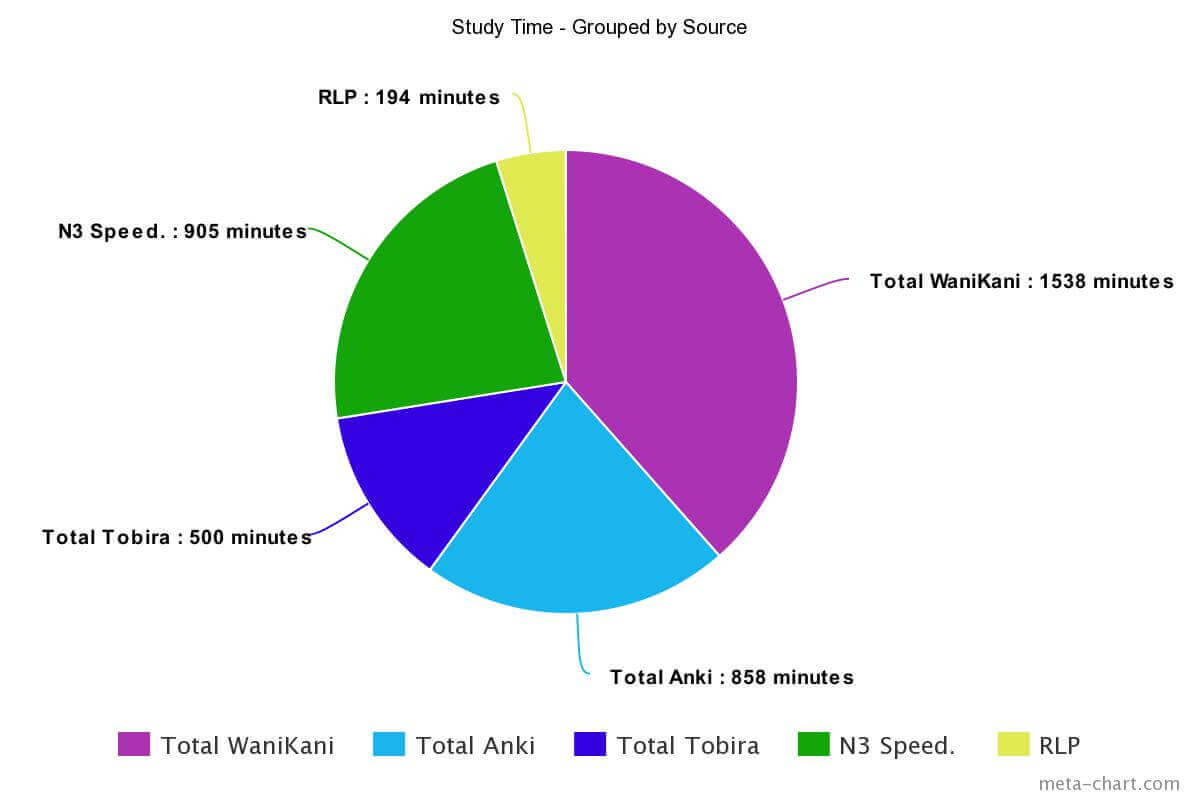
Thoughts on the Data for Study Time – Grouped by Source
I do not like the fact that most of my time was spent on WaniKani. Kanji is of course important, but since I’m currently living in Japan, my main goal is to improve my speaking and listening skills. Having the right tools, like a range of grammar and vocabulary under my belt, is far more important to me than how many kanji I can read. It’s certainly disheartening to see that I spent more time on WaniKani than Tobira, but even if I added Tobira with N3 Speedmaster, WaniKani still comes out on top. That small yellow sliver for Reading/Listening Practice is also quite troubling, as listening is one of my weakest skills. With all this time spent on WaniKani (and, heck, even Anki), how much of it is me learning new words and kanji?
Study Time – Individual
This is it: the final chart. I wanted to know what individual activity I did the most; I mean, that’s what prompted me into recording my study habits in the first place. Here are the results.
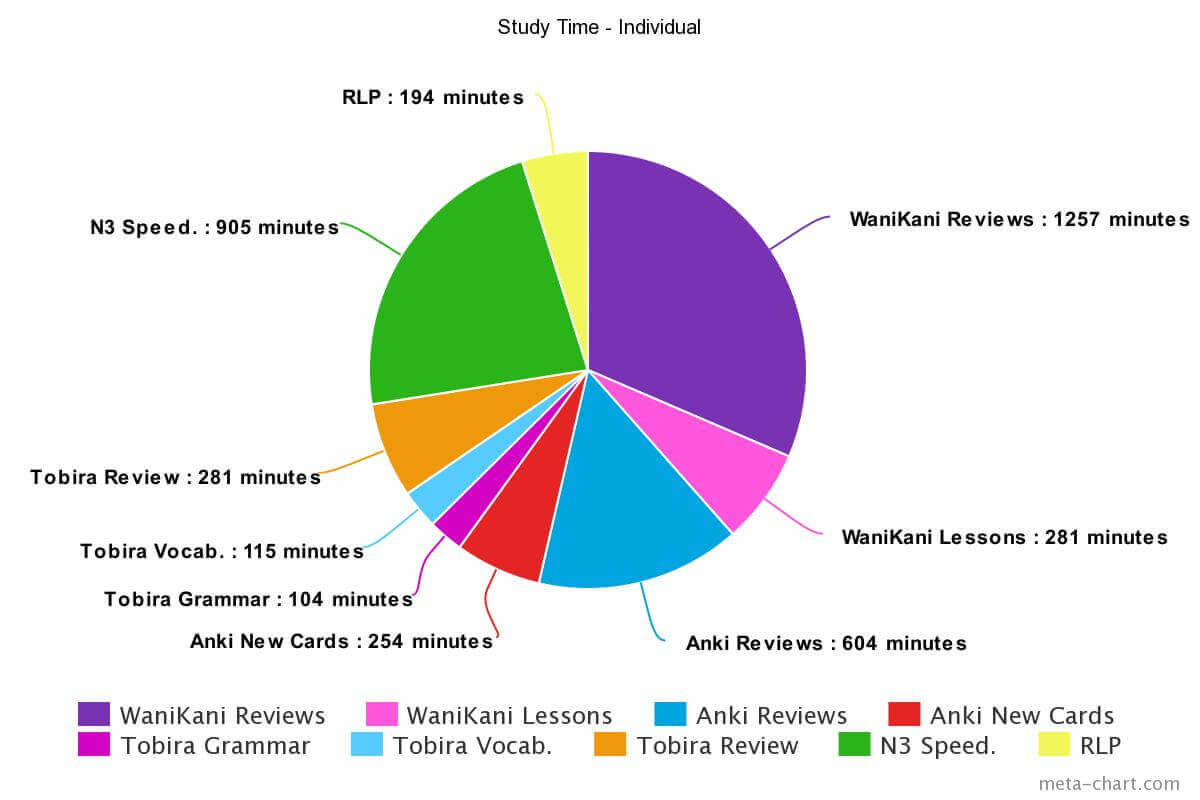
Thoughts on Data for Study Time – Individual
It’s astounding how much of my time was spent solely doing WaniKani reviews. I can, however, understand why this is. If you don’t keep up with your reviews, they’ll just continue to increase until you have a mountain of a backlog to contend with. Even though I planned out my time with Tobira, it’s much easier to procrastinate that than something like WaniKani. I receive e-mails every day with my lesson and review count, so I pretty much get a daily reminder of it all. I also rationalized my procrastination regarding Tobira: “Ah, I can just do four grammar points tomorrow instead of two”; “Well, if I study on the weekend, I can catch up”; or “If I just increase my daily amount from three to five grammar points, I can catch up in a few weeks.”
Where to Go from Here
Comparing the data against my goals clearly shows me that I have to change the way I’m studying. I think the biggest problem for me involves procrastination. Even though I’m still studying when I do things like Anki or WaniKani, they’re still preventing me from progressing. Though going through flashcards can be monotonous, it’s an easy task; not a lot of brain power is required. With studying grammar or practicing listening or speaking, I need to concentrate way more. It’s also more frustrating when I can’t successfully understand or communicate something, whereas I can somewhat easily move past getting a card wrong. I definitely need to aim for a better balance of study methods, including a lot more speaking.
Despite not being pleased with the results, I’m really happy that I kept track of my studying. It’s an eye-opening experience that allowed me to figure out what may not be working for me and what I need to change to keep moving forward in my language journey. Who knows? I might try this again sometime, just to make sure that I’m correctly heading towards Japanese fluency.
While it was eye-opening to examine my own study habits, I want to know about yours! Have you ever tried examining the way you use your study time? What were the results, and what do you think you can do better? Let me know in the comment section below! As always, I look forward to reading your thoughts! ^_^

Featured Sponsor - JAST
The sweetest romance and the darkest corruption, the biggest titles and the indie darlings; for visual novels and eroge, there's nowhere better.
Big thank you to our supporters
From their continous support, we are able to pay our team for their time and hard work on the site.
We have a Thank-You page dedicated to those who help us continue the work that we’ve been doing.
See our thank you page